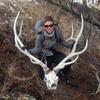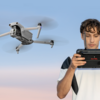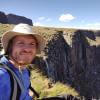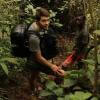With new technologies revolutionizing data collection, wildlife researchers are becoming increasingly able to collect data at much higher volumes than ever before. Now we are facing the challenges of putting this information to use, bringing the science of big data into the conservation arena. With the help of machine learning tools, this area holds immense potential for conservation practices. The applications range from online trafficking alerts to species-specific early warning systems to efficient movement and biodiversity monitoring and beyond.
However, the process of building effective machine learning tools depends upon large amounts of standardized training data, and conservationists currently lack an established system for standardization. How to best develop such a system and incentivize data sharing are questions at the forefront of this work. There are currently multiple AI-based conservation initiatives, including Wildlife Insights and WildBook, that are pioneering applications on this front.
This group is the perfect place to ask all your AI-related questions, no matter your skill level or previous familiarity! You'll find resources, meet other members with similar questions and experts who can answer them, and engage in exciting collaborative opportunities together.
Just getting started with AI in conservation? Check out our introduction tutorial, How Do I Train My First Machine Learning Model? with Daniel Situnayake, and our Virtual Meetup on Big Data. If you're coming from the more technical side of AI/ML, Sara Beery runs an AI for Conservation slack channel that might be of interest. Message her for an invite.
Header Image: Dr Claire Burke / @CBurkeSci

Explore the Basics: AI
Understanding the possibilities for incorporating new technology into your work can feel overwhelming. With so many tools available, so many resources to keep up with, and so many innovative projects happening around the world and in our community, it's easy to lose sight of how and why these new technologies matter, and how they can be practically applied to your projects.
Machine learning has huge potential in conservation tech, and its applications are growing every day! But the tradeoff of that potential is a big learning curve - or so it seems to those starting out with this powerful tool!
To help you explore the potential of AI (and prepare for some of our upcoming AI-themed events!), we've compiled simple, key resources, conversations, and videos to highlight the possibilities:
Three Resources for Beginners:
- Everything I know about Machine Learning and Camera Traps, Dan Morris | Resource library, camera traps, machine learning
- Using Computer Vision to Protect Endangered Species, Kasim Rafiq | Machine learning, data analysis, big cats
- Resource: WildID | WildID
Three Forum Threads for Beginners:
- I made an open-source tool to help you sort camera trap images | Petar Gyurov, Camera Traps
- Batch / Automated Cloud Processing | Chris Nicolas, Acoustic Monitoring
- Looking for help with camera trapping for Jaguars: Software for species ID and database building | Carmina Gutierrez, AI for Conservation
Three Tutorials for Beginners:
- How do I get started using machine learning for my camera traps? | Sara Beery, Tech Tutors
- How do I train my first machine learning model? | Daniel Situnayake, Tech Tutors
- Big Data in Conservation | Dave Thau, Dan Morris, Sarah Davidson, Virtual Meetups
Want to know more about AI, or have your specific machine learning questions answered by experts in the WILDLABS community? Make sure you join the conversation in our AI for Conservation group!
No showcases have been added to this group yet.
- @SamuelNtimale
- | Him
Samuel Nti, a conservationist at APLORI, uses bioacoustics to protect endangered birds. His current work focuses on the African Grey Parrot in Nigeria, where he employs Passive Acoustic Monitoring (PAM) to inform conservation strategies.

- 0 Resources
- 1 Discussions
- 7 Groups
HaMaarag
Quantitative ecologist
- 0 Resources
- 0 Discussions
- 3 Groups
- 0 Resources
- 0 Discussions
- 3 Groups
- @emcandler
- | she/her
- 0 Resources
- 0 Discussions
- 6 Groups
- @kaitlyngaynor
- | she/her, they/them


- 0 Resources
- 0 Discussions
- 3 Groups
- @frankglujan
- | He/Him/His
- 0 Resources
- 0 Discussions
- 3 Groups
Cardiff University
- 0 Resources
- 0 Discussions
- 3 Groups
Scaling biodiversity monitoring, using smart sensors and ai-pipelines

- 0 Resources
- 2 Discussions
- 10 Groups
- @prabath
- | he/him
I'm a Computer Vision researcher with a keen interest in Conservation tech. Currently involved in a project to detect wild cat behavior using trail camera images.
- 0 Resources
- 0 Discussions
- 1 Groups
- @hpishdast2023
- | she/her
- 0 Resources
- 0 Discussions
- 4 Groups
Max Planck Institute of Animal Behavior
Project leader of MoveApps | Movement ecology

- 1 Resources
- 5 Discussions
- 5 Groups
- @hailin
- | chl
I am a scientist in charge of animal AI identification at the Tangjiahe Nature Reserve in Sichuan. My main job is to use AI to identify giant pandas and infer where they will appear in the future and conduct biological analysis of feces. I would like to join this community to com

- 0 Resources
- 0 Discussions
- 3 Groups
In a first, UMass Amherst, Cornell use AI to mine big migration data on massive scale
9 October 2019
Rutgers University, Microsoft AI for Earth, Google Earth Outreach and San Diego Zoo Global are proud to announce the world’s first camera trap technology symposium, to take place November 7th and 8th at Google...
2 September 2019
Sharing failure, tech support for conservation, roaming mentors, conservation tech hype cycles and developing new road maps - participants in our tech workshops at ICCB 2019 shared an abundance of ideas for how to shape...
21 August 2019
In this case study, Cooper Oelrichs of Save Indonesian Endangered Species Fund (SIES) breaks down his proposal for the development and training of an automated rhino identification system from limited camera trap data.
27 July 2019
The WILDLABS TECH HUB is supporting technology solutions tackling the illegal wildlife trade, in collaboration with the Foreign & Commonwealth Office, Digital Catapult, Satellite Applications Catapult, Amazon Web...
4 June 2019
To further their missions, LDF and Microsoft are collaborating on the AI for Earth innovation grant to support applicants in creating and deploying open source machine learning models, algorithms, and data sets that...
4 June 2019
Traditionally, illegal wildlife trade thrived in physical markets. But today it has also moved online. In China, more than half of the trade in elephant ivory items happens on e-commerce platforms. Enrico Di Minin and...
31 May 2019
This webinar recording will provide a brief overview of current SMART functionality, highlight case studies of large scale and innovative SMART deployments, and detail how SMART is embracing and leveraging new...
21 May 2019
In February, we released an open call for the WILDLABS TECH HUB, offering 3 months of support for solutions using technolgy to tackle the illegal wildlife trade. We were overwhelmed by an incredible 37 submissions,...
13 May 2019
To realise the potential benefits of data for our societies and economies we need trustworthy data stewardship. We need to establish different approaches to deciding who should have access to data, for what purposes and...
15 April 2019
Happy World Wildlife Day! To celebrate, this week we've asked our community to share photos showing how they are using tech in the field or the lab, using the #Tech4Wildlife hashtag.
3 March 2019
After a promising first run in Namibia, a Swiss project could aid savanna conservation using drones and automatic image analysis.
18 February 2019
August 2025
event
September 2025
event
event
event
event
October 2025
event
event
event
December 2025
event
March 2026
September 2024
event
event
17 Products
Recently updated products
| Description | Activity | Replies | Groups | Updated |
|---|---|---|---|---|
| @DibblexLesalon looks like a great question for your team at Expert Drones Africa :) |
|
AI for Conservation | 1 year ago | |
| However, I think it's important to reflect further to determine exactly what needs to be done. |
+8
|
Climate Change, AI for Conservation, Animal Movement, Citizen Science | 1 year ago | |
| Congrats on the publication! Great work! |
|
AI for Conservation | 1 year ago | |
| The German start-up Dryad is also working on early fire detection using sensors and AI. |
|
AI for Conservation | 1 year ago | |
| I found this interesting |
+48
|
AI for Conservation, Emerging Tech | 1 year ago | |
| Really interesting, I will take a look |
|
AI for Conservation, Camera Traps, Data management and processing tools, Emerging Tech | 1 year ago | |
| Great new!! |
+15
|
AI for Conservation | 1 year ago | |
| Hi Carly, thank you for the advice! I am only focusing on the two birds for now - my goal is to use part of the iNaturalist data I have pulled to train the model and the rest to... |
|
AI for Conservation | 1 year ago | |
| Thank you so much! Now everything is in the hands of amazing organizations and companies! But the first results of the Disaster Management cohort are bringing a very optimistic... |
|
AI for Conservation, Climate Change, Early Career, East Africa Community, eDNA & Genomics, Emerging Tech, Ending Wildlife Trafficking Online, Human-Wildlife Coexistence, Open Source Solutions | 1 year ago | |
| great! |
|
AI for Conservation | 1 year ago | |
| interesting!!! |
|
AI for Conservation, Animal Movement, Data management and processing tools | 1 year ago | |
| so great!!! |
|
Software Development, AI for Conservation, Animal Movement | 1 year ago |
Automated moth monitoring & you!
24 October 2023 8:52am
Biodiversity modelling in the AI era
23 October 2023 12:03pm
Soundscapes and deep learning enable tracking biodiversity recovery in tropical forests
20 October 2023 3:38pm
ZSL Research Fellow (x3 roles)
20 October 2023 3:34pm
PhD Opportunity: YELLOWHAMMER - Individual acoustic monitoring to study song culture evolutionwithin and between dialect areas
20 October 2023 12:54pm
PhD Opportunity: Distributed sound source localisation and separation for wireless microphone networks consisting of two-microphone nodes
20 October 2023 12:47pm
PhD Opportunity: 'FLOATERS' position at Bioacoustic AI Doctoral Network
20 October 2023 12:36pm
Catch up with The Variety Hour: October 2023
19 October 2023 11:59am
Anyone else attending ADSA in Texas next week?
17 October 2023 8:46pm
Practical strategies for conservationists in an increasingly digital world
9 October 2023 5:04pm
Leveraging new digital technologies for conservation impact
9 October 2023 4:39pm
AI Challenge aiming to automate the identification process of sea turtles
6 October 2023 11:38am
Four Amazing Impacts of This A.I.-Powered Bird Migration Tracker | Science| Smithsonian Magazine
5 October 2023 4:26pm
GEO BON Monitoring Biodiversity for Action
5 October 2023 3:10pm
Mozilla Foundation, funding for nature conservation
4 October 2023 6:30pm
🚀 New Grant: 'Satellites for Biodiversity Award' Round 2
2 October 2023 1:50pm
GIS & Data Science Specialist
28 September 2023 1:32pm
Conservation Innovation Manager
27 September 2023 11:08pm
1st Wildlife Scientific Conference 2023
25 September 2023 11:10am
Geospatial Data Scientist, Varaha
25 September 2023 9:58am
Digital Disruption for Conservation Toolkit
22 September 2023 12:18pm
IUCN and AI2 to provide AI technology at no cost to fast-track implementation of newly signed UN High Seas Treaty
22 September 2023 9:54am
Q&A: UK NERC £3.6m AI (image) for Biodiversity Funding Call - ask your questions here
13 September 2023 4:10pm
*NEW* White Paper: Harnessing the Power of Sound & AI to track Global Biodiversity Framework (GBF) Targets
20 September 2023 12:53pm
DSAIL Tech4Wildlife Workshop Tutorials Now Available!
20 September 2023 12:22pm
Mozilla Technology Fund: AI and Environmental Justice Awards
15 September 2023 12:09pm
In case you missed it... (no. 1)
12 September 2023 11:49am
13 September 2023 6:23am
CIEEM 2023 Autumn Conference: Modernising Ecology: Techniques and Approaches
5 September 2023 1:59pm
Where to start in ct ?
1 September 2023 2:50pm
2 September 2023 12:53am
Hi Lucas.
I can understand that there are a lot of technologies being thrown around and it can be confusing about what is really needed. I recommend to first select an area of conservation you want to focus in, ie: ecological restoration, soil conservation, wildlife management, etc. Based on that decision, look at what technologies are available that can potential help in that field. We do a lot of work in ecological restoration and find that long term, longitudinal monitoring of conservation reserves are important. Because of that, we use a lot of datalogging and wireless communications to monitor remote locations. If you're interested in invasive species management, you might be drawn towards wildlife tracking (movement ecology), trap monitoring, drones, etc.
The technology is a tool, and you should look at it like field gear. The gear will change depending on what you're setting out to do and the tool is supposed to make your life easier, not harder :)
Hope that helps.
Akiba
2 September 2023 6:14am
Very helpful, thank you. One more thing, are there any broad skills that apply to all areas of conservation tech that may be helpful to learn/improve, e.g data analysis?
DSAIL Tech4Wildlife Workshop
1 September 2023 11:32am
26 September 2023 6:54am
26 September 2023 9:19am






























































21 September 2023 4:27pm
This is super cool! Me and @Hubertszcz and @briannajohns and several others are all working towards some big biodiversity monitoring projects for a large conservation project here in panama. The conservation project is happening already, but hubert starts on the ground work in January and im working on a V3 of our open source automated insect monitoring box to have ready for him by then.
I guess my main question would be if this funding call is appropriate/interested for this type of project? and what types of assistance are possible through this type of funding (researchers? design time? materials? laboratory field construction)